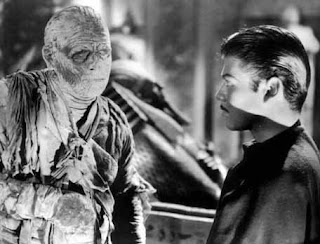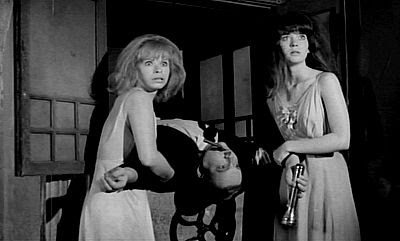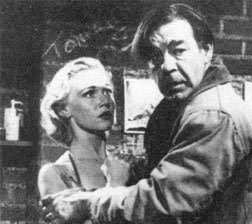The Mummy's Hand (1940)
Starring: Dick Foran, Wallace Ford, Peggy Moran, George Zucco, and Tim Tyler
Director: Christy Cabanne
Rating: Six of Ten Stars
A pair of hard-luck Egyptologists (Foran and Ford) discover the location of the long lost tomb of Princess Ananka. Unfortunately for them, an evil cult leader (Zucco) controls the immortal, tomb-guarding, tanna leaf-tea slurping mummy Kharis, and he's hot afraid to use him to keep the secret of the tomb.

More of an adventure flick with a heavy dose of lowbrow comedy than a horror film, "The Mummy's Hand" isn't even a proper sequel to the classy 1932 "The Mummy."
This movie (and the three sequels that follow) are completely unrelated to the original film, despite the copious use of stock footage from it. The most obvious differences are that the mummy here is named Kharis, as opposed to Imhotep, and has a different backstory. Then, there's the fact he's a mindless creature who goes around strangling people at the bidding of a pagan priest where Imhotep was very much his own man and did his killing with dark magics without ever laying a hand on his victims.
If one recognizes that this film shares nothing in common with the Boris Karloff film (except that they were both released by the same studio), "The Mummy's Hand" is a rather nice bit of fluff. It's also the first film to feature the real Universal Studios mummy, as Imhotep was an intelligent, scheming, and more-or-less natural looking man, not a mute, mind-addled, bandaged-wrapped, cripple like Kharis.
The Mummy's Tomb (1942)
Starring: Wallace Ford, Turhan Bey, John Hubbard, George Zucco, Dick Foran, Isobel Evans, and Lon Chaney Jr.
Director: Harold Young
Rating: Three of Ten Stars
Thirty years after the events of "The Mummy's Hand, the High Priest of Karnak from the last film (Zucco), who, despite being shot four times and pointblank range and tumbling down a very long flight of stairs, survived to be an old man. He passes the mantle onto a younger man (Bey) and dispatches him to America with Kharis the Mummy (Chaney), who survived getting burned to a crisp at the end of the last movie, to slay those who dared loot the tomb of Princess Anankha. (Better late than never, eh?)

Take the plot of "The Mummy's Hand" (complete with a villain who has the exact same foibles as the one from the first movie), remove any sense of humor and adventure, toss in about ten minutes of recap to pad it up to about 70 minutes in length, add a climax complete with torch-weilding villagers and a mummy who is just too damn dumb to continue his undead existence, and you've got "The Mummy's Tomb."
Made with no concern for consistency (Ford's character changes names from Jenson to Hanson, the fashions worn in "The Mummy's Hand" implied it took place in the late 30s, or even in the year it was filmed, and yet "thirty years later" is clearly during World War II... and let's not even talk about how the mummy and Zucco's character survived) or originality (why write a whole new script when we can just have the bad guys do the exact same things they did last movie?), this film made with less care than the majority of B-movies.
Turhan Bey and Wallace Ford have a couple of good moments in this film, but they are surrounded by canned hash and complete junk.
The Mummy's Ghost (1944)
Starring: John Carradine, Ramsay Ames, Robert Lowery, George Zucco, and Lon Chaney Jr
Director: Reginald Le Borg
Rating: Three of Ten Stars
Modern day priests of ancient Egyptian gods (Zucco and Carradine) undertake a mission to retrieve the cursed mummy of Princess Ananka from the American museum where she's been kept for the past 30 years. Unfortunately, they discover that the archeologists who stole her away from Egypt broke the spell that kept her soul trapped in the mummy and that she has been reincarnated in America as the beautiful Amina (Ames).

"The Mummy's Ghost" starts out strong. In fact, it starts so strong that, despite the fact that the priests who must be laughing stock of evil cult set were back with pretty much the exact same scheme for the third time (go to America and send Kharis the Mummy stumbling around to do stuff, that it looked like the filmmakers may have found their way back to the qualities that made "The Mummy" such a cool picture.
Despite a really obnoxious love interest for Amina (played with nails-on-a-chalkboard-level of obnoxiousness by Robert Lowery) and a complete resurrection of Kharis (boiling tannith leaves now apparently reconstitutes AND summons a mummy that was burned to ashes in a house-fire during "The Mummy's Tomb"), and a number of glaring continuity errors with the preceding films (the cult devoted to Ananka and Kharis has changed their name... perhaps because they HAD become the laughing stock among the other evil cults), the film is actually pretty good for about half its running time. The plight of and growing threat toward Amina lays a great foundation.
And then it takes a sharp nosedive into crappiness where it keeps burrowing downward in search of the bottom.
The cool idea that the film started with (Ananka's cursed soul has escaped into the body of a living person... and that person must now be destroyed to maintain the curse of the gods) withers away with yet another replay of the evil priest deciding he wants to do the horizontal mambo for all enternity with the lovely female lead. The idea is further demolished by a nonsensical ending where the curses of Egypt's ancient gods lash out in the modern world, at a very badly chosen target. I can't go into details without spoiling that ending, but it left such a bad taste in my mouth, and it's such a complete destruction of the cool set-up that started the film, that the final minute costs "The Mummy's Ghost" a full Star all by itself.
The Mummy's Curse (1944)
Starring: Peter Coe, Lon Chaney Jr, Kay Harding, Dennis Moore, Virginia Christine, and Kurt Katch
Director: Leslie Goodwins
Rating: Three of Ten Stars
A construction project in Louisiana's bayou uncovers not only the mummy Kharis (Chaney), but also the cursed princess Ananka (Christine). Pagan priests from Egypt arrive to take control of both. Mummy-induced violence and mayhem in Cajun Country follow.
What happens when you make a direct sequel where no one involved cares one whit about keeping continuity with previous films? You get "The Mummy's Curse"!
For the previous entries in this series, Kharis was shambling around a New England college town, yet he's dug up in Louisiana. (He DID sink into a swamp at the end of "The Mummy's Ghost", but that swamp was hundreds of miles north of where he's found in this film.)
He also supposedly has been in the swamp for 25 years. For those keeping score, that would make this a futuristic sci-fi film with a setting of 1967, because the two previous films took place in 1942. (And that's being generous. I'm assuming "The Mummy's Hand" took place in 1912, despite the fact that all clothing and other signifiers imply late 30s early 40s.) Yet, there's nothing in the film to indicate that the filmmakers intended to make a sci-fi movie.
And then there's Ananka. Why is she back, given her fate in "The Mummy's Ghost"? There's absolutely no logical reason for it. Her resurrection scene is very creepy, as is the whole "solar battery" aspect of the character here, but it is completely inconsistent with anything that's gone before. And she's being played by a different actress--but I suppose 25 years buried in a swamp will change anyone.
There's little doubt that if anyone even bothered to glance at previous films for the series, no one cared.
Some things the film does right: It doesn't have the Egyptian priests replay exactly the same stuff they've done in previous films for the fourth time (although they are still utter idiots about how they execute their mission), it manages for the first time to actually bring some real horror to the table--Kharis manages to be scary in this film, and I've already mentioned Ananka's creep-factor--and they bring back the "mummy shuffling" music from "The Mummy's Ghost" which is actually a pretty good little theme. But the utter disregard for everything that's happened in other installments of the series overwhelm and cancel out the good parts.
"The Mummy's Curse" should not have been slapped into the "Kharis" series. If it had been made as a stand-alone horror film, it could have been a Six-Star movie. As it is, this just comes across as a shoddy bit of movie making where I can only assume that anything decent is more by accident than design.






















.jpg)





.jpg)
